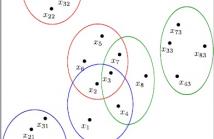
- Read more about TS-MC: Two stage matrix completion algorithm for Wireless sensor networks
- Log in to post comments
- Categories:
 7 Views
7 Views
- Read more about ALGEBRAICALLY-INITIALIZED EXPECTATION MAXIMIZATION FOR HEADER-FREE COMMUNICATION
- Log in to post comments
- Categories:
 9 Views
9 Views
- Read more about On Optimal Sensing and Capacity Trade-off in Cognitive Radio Systems with Directional Antennas
- Log in to post comments
We consider a cognitive radio system, in which the secondary users (SUs) and primary users (PUs) coexist. The SUs are equipped with steerable directional antennas. In our system, the secondary transmitter (SUtx) first senses the spectrum (with errors) for a duration of τ, and, then transmits data to the secondary receiver (SUrx) if spectrum is sensed idle. The sensing time as well as the orientation of SUtx's antenna affect the accuracy of spectrum sensing and yield a trade-off between spectrum sensing and capacity of the secondary network.
- Categories:
 8 Views
8 Views
- Read more about Optimal Local Thresholds for Distributed Detection in Energy Harvesting Wireless Sensor Networks
- Log in to post comments
- Categories:
 6 Views
6 Views
We consider the problem of jointly registering multiple point sets using rigid transforms. We propose a distributed algorithm based on consensus optimization for the least-squares formulation of this problem. In each iteration, the computation is distributed among the point sets and the results are averaged. For each point set, the dominant cost per iteration is the SVD of a square matrix of size d, where d is the ambient dimension. Existing methods for joint registration are either centralized or perform the optimization sequentially.
- Categories:
 35 Views
35 Views
- Read more about ELITE GRADIENT DESCENT OPTIMIZATION OF ANTENNA PARAMETERS CONSTRAINED BY RADIO COVERAGE IN GREEN CELLULAR NETWORKS
- Log in to post comments
The power consumption of the base stations is the major part of the total consumption of mobile communications, which implies that it is of great significance to reduce the radio transmit power consumption of base stations under the constraint of quality of service. The dynamic of the traffic leads to the adaptive adjustment of the antenna parameters of the base stations or even turning off some base stations serving low user traffic.
globalsip.pdf
- Categories:
 15 Views
15 Views
- Read more about ELITE GRADIENT DESCENT OPTIMIZATION OF ANTENNA PARAMETERS CONSTRAINED BY RADIO COVERAGE IN GREEN CELLULAR NETWORKS
- Log in to post comments
globalsip.pdf
- Categories:
 3 Views
3 Views
Using information about the wireless communica- tion channel is a well known approach to estimate a users position. So far it has been shown that such methods can provide positioning information in line-of-sight (LOS) situations by estimating channel properties like time of flight, direction of arrival, and direction of departure of a link between a single access point and station. In this paper we focus on mmWave channels and propose a method that allows positioning in indoor scenarios even under non-line-of-sight conditions by exploiting the presence of scatterers.
- Categories:
 60 Views
60 Views

- Read more about Robust 3D Localization of Underwater Optical Wireless Sensor Networks via Low Rank Matrix Completion
- Log in to post comments
Location is one of the basic information required for underwater optical wireless sensor networks (UOWSNs) for
three main purposes: 1) Relating the sensing measurements with precise sensor positions, 2) Enabling efficient routing techniques by exploiting the sensor locations, and 3) Sustaining link connectivity
and performance via pointing and alignment mechanisms between the nodes. Even though various two-dimensional
UOWSN_Loc.pdf
- Categories:
 35 Views
35 Views